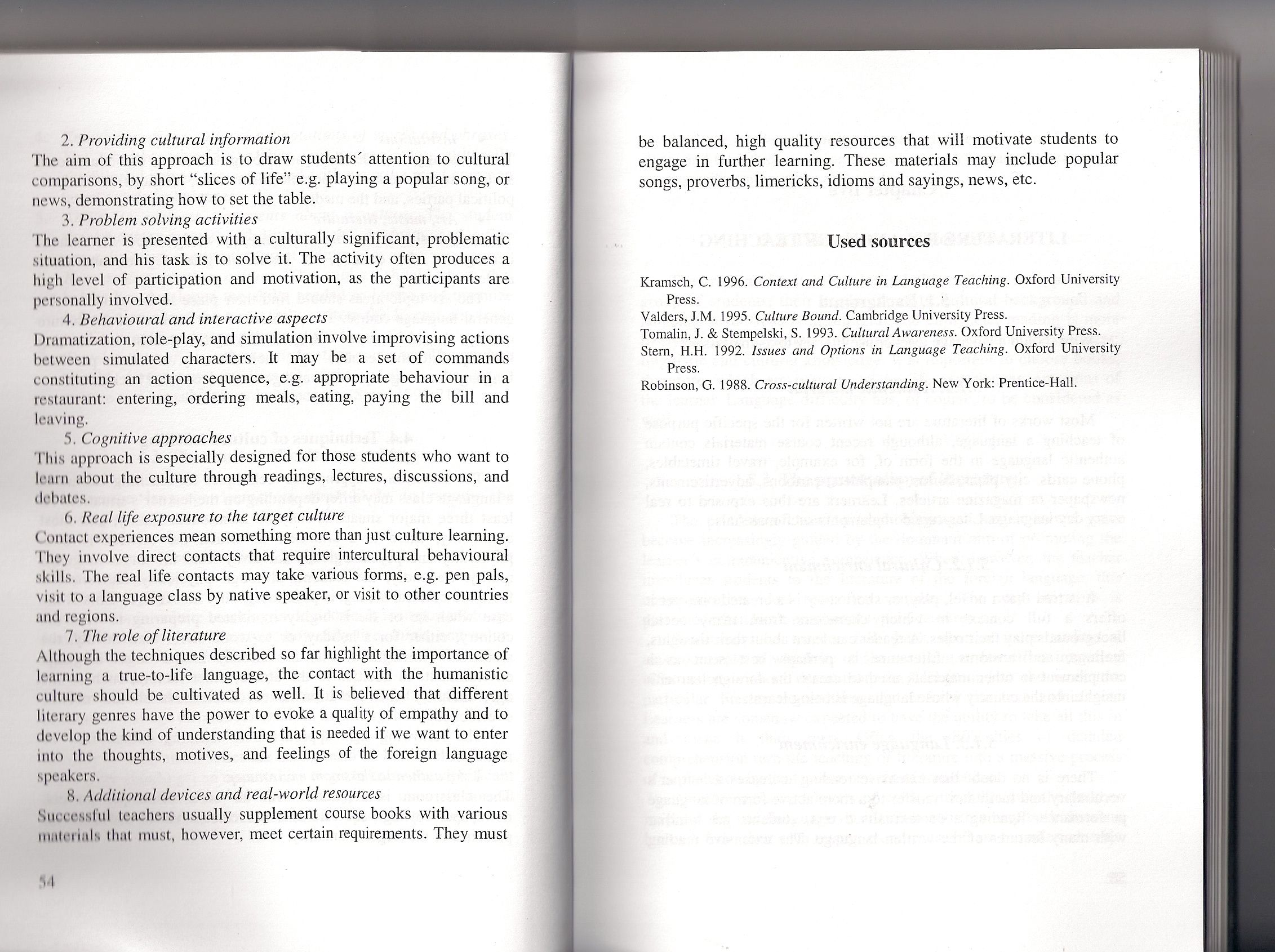50120 skanowanie0027 (22)


2. Providing cultural information
The aim of this approach is to draw students' attention to cultural comparisons, by short “slices of life” e.g. playing a popular song, or news, demonstrating how to set the table.
3. Problem solving activities
The leamer is presented with a culturally significant, problematic situation, and his task is to solve it. The activity often produces a high level of participation and motivation, as the participants are personally involved.
4. Behavioural and interactive aspects
Dramatization, role-play, and simulation involve improvising actions between simulated characters. It may be a set of commands constituting an action seąuence, e.g. appropriate behaviour in a restaurant: entering, ordering meals, eating, paying the bill and leaving.
5. Cognitive approaches
This approach is especially designed for those students who want to learn about the culture through readings, lectures, discussions, and dcbutcs.
6. Real life exposure to the target culture
Contact experiences mean something morę than just culture learning. 'I'hey involve direct contacts that reąuire intercultural behavioural skills. The real life contacts may take various forms, e.g. pen pals, visit to a language elass by native speaker, or visit to other countries and regions.
7. The role of literaturę
Although the techniąues described so far highlight the importance of learning a true-tp-life language, the contact with the humanistic culture should be cultivated as well. It is believed that different lilerary genres have the power to evoke a ąuality of empathy and to develop the kind of understanding that is needed if we want to enter into the thoughts, motives, and feelings of the foreign language speakers.
8. Additional devices and real-world resources
Successlul teachers usually supplement course books with various mntcriftll tluit mustJ however, meet certain reąuirements. They must be balanced, high ąuality resources that will motivate students to engage in further learning. These materials may include popular songs, proverbs, limericks, idioms and sayings, news, etc.
Used sources
Kramsch, C. 1996. Contact and Culture in Language Teaching. (Mord University Press.
Valders, J.M. 1995. Culture Bound. Cambridge University Press.
Tomalin, J. & Stempelski, S. 1993. Cultural Awareness. (Mord University Press. Stern, H.H. 1992. Issues and Options in Language Teaching. (Mord University Press.
Robinson, G. 1988. Cross-cultural Understanding. New York: Prentice-Hall.
Wyszukiwarka
Podobne podstrony:
DSC07314 SUMMARY CULTURAL HERITAGE OF OPOLE REGION VILLAGES - PRESERVATION ISSUES The aim of this re
Exercises class Description: The aim of this course is to provide an opportunity to develop skills o
LABORATORY OF THE INTER-DOMAIN ROUTING - BGP SECURITYAbstract The aim of this work is to analyse the
44 M. SIKORSKI ABSTRACT The aim of this paper is to review the most widely used techniąue for studie
CCI20121023�16 Stylistyka XVIIIAdministrative Polish and its Variants The aim of this paper is to ma
PROBLEMY PIELĘGNIARSTWA 2014, tom 22, zeszyt nr 3 Aim. The purpose of this study is to analyze opini
PROBLEMY PIELĘGNIARSTWA 2014, tom 22, zeszyt nr 3 Aim. The purpose of this study is to analyze opini
REYERSE ENGINEERING - PISTON SCANNING Abstract The aim of this work was to use reverse engineering t
W języku angielskim: The aim of today’s lesson is to check your ability to react in everyday life si
132 I. Steinka I. Steinka TECHNOLOGY INNOVATIONS AS A FACTOR OF FOOD SAFETY Summaiy The aim of this
6 4 2 rclosing phrase opening phrase ("joining") The main aim of this phrase is to lead to
Effect Of Dividends On Stock Prices 18 The objective of this study is to analysis the relationship b
więcej podobnych podstron